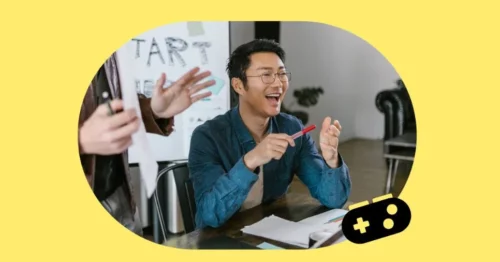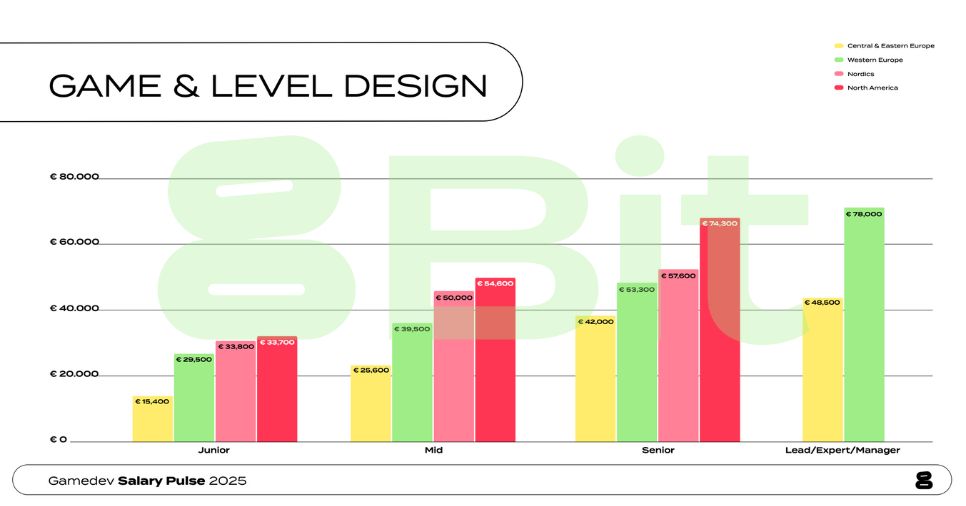
Comprehensive Guide to Game Development Roles: Focus on Game Design Jobs
See similar blog posts

Our ultimate Game Design Jobs recruitment guide is here to equip you with all the insider knowledge, expert tips, and job search strategies you need to level up your career in the gaming industry.
Today we’re gonna discuss the different faces of Game Design Jobs. What a game designer does, what roles/competencies do you need to form a solid game design Team? What is the difference between different roles in video game design?
According to LinkedIn Talent Insights, a staggering 305,414 professionals worldwide mention Game Design and Video Game Design among their skills. This number marks a significant 19% growth year over year, and nearly 47,000 of those individuals have changed companies during the past year, signifying a strong trend in job transitions.
As of August 2023, there are 5,077 job posts requiring game design skills.
Whether you’re a seasoned pro or just embarking on your journey into the gaming industry, our comprehensive recruitment guide is tailored to equip you with the insider knowledge, expert tips, and strategies needed to navigate this bustling field.
Also, if you want to know what are the other fields in the video game industry, check out the other parts of our game dev roles compendium:
Table of contents:
- 👉Intro
- 👉Game Director / Creative Director
- 👉Gameplay Designer
- 👉Level Designer
- 👉System Designer
- 👉Technical Game Designer
- 👉Monetization Designer
- 👉Writer
- 👉Narrative Designer
- 👉UX / UI Designer
- 👉Junior / Associate Game Designer
Roles in Game Design – intro (scroll down if you want the specifics. We won’t mind)
Game Designers are people responsible for creating the core of the game itself – the gameplay. They’re tweaking and balancing (and playtesting – don’t forget about that part) all parts of the game. They create levels where all the magic happens.
Game Designer’s job is designing all mechanics that make the game the way it should be.
This role is very versatile, and you can say that it’s a bridge connecting various teams in the game studio.
In indie game studios – commonly, game designers handle every aspect of building gameplay (game designer does it all: level design, gameplay design, quests, story – you name it).
In the bigger studios, you see that different people work on separate parts of the game design. And that’s why we’re gonna list what each of these game design team roles does specifically. So you can have a nice understanding of who does what.
In larger studios, different designers take on more focused responsibilities, which is why we’re breaking down the key roles within game design teams to help you understand who does what.
In the image, we’re sharing the annual gross median salaries for Game Designers across different regions. For more insights into salary trends, job security, and work conditions in gamedev, we recommend checking out our free industry report: Gamedev Salary Pulse 2025.

Game Director / Creative Director role in the game industry
When someone says that they dream of becoming a game designer, they probably think about this particular role.
The Game Director guides the rest of the development team to achieve the desired vision of the game (which he often creates). This person makes sure that every aspect of production leads to the creation of THE game. And by every, I mean: design, story, etc. (Sometimes even art, where there’s no Art Director on the board.)
If an Art Director is present, then these two work in tight cooperation.
Gameplay Designer role in gamedev
Gameplay Designer takes care of the… (suspense is killing you, I presume)
core aspects of the gameplay! This role works on game mechanics, different game modes (if the game is supposed to have them), and the player’s progression.
They’re constantly tweaking the game. Testing and checking if the mechanics they created are fun and clear enough for the player. Their goal is to make gamer’s experiences as engaging as possible.
Level Designer role in game development
If the gameplay designer builds mechanics, the level designer’s job is to create an “interactive playground” where they can be used.
They plan what will happen to the player during his playthrough.
Are there any encounters, puzzles? They define the goals and objectives for each stage,
make layouts of traversable environments. They build rough mockups of terrains using simple shapes. This is called “blocking-out.” Block-out helps Level Designer check if the map is clear enough for the players (does the player know where he needs to go? Cause if he doesn’t, it’s a slight mess up, which needs to be taken care of). Is it fun enough to play?
Read more on what is level design and what level designer does.
System Designer role in game development
These experts live and breathe spreadsheets, using them to meticulously craft the balance within a game. From economics and stats to points and rewards, their detailed planning orchestrates the seamless flow of play. The work of a system designer is evident in the crafting of combat scenarios, character progression, enemy spawn rates, and even the nuances of in-game shopkeepers. Their decisions impact the satisfaction of leveling up and the equilibrium of crafting items.
But their job isn’t just about creation; it’s also about continual refinement to ensure that the game’s performance is optimal. They monitor and adjust in-game resources, keeping an eye on all elements to guarantee a satisfying and smooth gaming experience.
If a game still captivates you after 30 hours of play, you can tip your hat to the system designer. Their mastery over the many facets of game mechanics ensures that balance, challenge, and excitement are sustained throughout your adventure.
Technical Game Designer role in game development
This role marries the creative world of game design with the logical precision of programming. While they may not delve as deeply into the code as a standard game programmer, technical designers are adept at working within a game engine, applying code directly related to gameplay.
Technical designers act as the bridge between the conceptual ideas of other designers and the tangible, playable prototypes. With their programming know-how, they can quickly translate ideas into something that can be playtested, even by those with limited programming knowledge. Their prototypes may not always have the most refined code, but their purpose is to prototype swiftly, iterate, and see how elements work, rather than creating a polished final product.
They play a pivotal role in fine-tuning the more subtle aspects of the game, such as rate of fire or movement speed. By manipulating these variables, they empower other designers to make adjustments autonomously, enhancing efficiency and collaboration.
Monetization Designer role in video game development
You can spot these folks within structures of free-to-play companies. Suppose you encounter a mobile title filled with microtransactions. In that case, you can be sure that the monetization designer dipped his fingers into it.
Monetization Designers are setting the prices, maintaining the economy of F2P video games, the currencies. They’re taking care of the balance between making a profit and still providing fun gaming service to the players (so they will pay).
Writer role in Gamedev
The writer deals with the words: The story, dialogues. And I could stop right here tbh.
These guys are standing behind the game lore. If it helps, you can easily compare this role to the screenwriter. They don’t need to worry too much about the gameplay.
Writers are often hired as freelancers.
Narrative Designer role in game development
So what’s the difference between a Narrative Designer and a Writer? People confuse these two roles so often.
The Narrative Designer is using the game mechanics to “tell a story.” He is using all the needed systems and tools to communicate a message to the player. Narrative Designers work with constraints that the Writer doesn’t have. They always need to check if the story goes well along with the gameplay.
UX / UI Designer role in the game industry
These guys are placing all the user interfaces, menus, buttons, HUDs that are assisting you during the game. They make sure that the elements are clear and readable to the player. Their goal is to navigate players through the playthrough and place all needed features where a player would expect them to find.
(It’s not unusual for an art person to take upon this role. The other good combo is when a game designer cooperates with a UI designer [an art person]. The Game Designer specifies gameplay-related requirements, and the UI designer translates them into one readable and cool-looking UI.
Read more on UX / UI Designer role in the episode of Gamedev Insights
What does Junior / Associate Game Designer do?
These are the entry-level positions. Junior Game Designers need support and supervision from other game designers. Also, they need to focus on executing tasks given to them rather than calling the shots.
Look at this as your first step on your journey to become a regular full-fledged Game Designer.
Interested? Read our Must-read guide if you want to become a game designer
You may also like our list of 5 top game design jobs books
Hungry for even more? Watch the episode of Gamedev Insights with Bartosz Rakowski, Game Designer!
That wraps up the part of our guide on careers in game development, specifically focusing on Game Design jobs. For more updates and job openings in the gaming industry, be sure to follow our LinkedIn page. See you there!
Editor’s note: This post was originally published in September 2021 and has been updated for comprehensiveness.